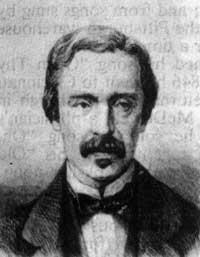Jean-Bernard-Leon Foucault
Born in Paris on 18 September 1819. After studying and obtaining the medical degree, he met with physicist Armand Fizeau and decided to deal with physics. He began to investigate heat and especially light.
Let us think that a ray of light falls on mirror A and is reflected with an angle. Suppose the reflected light beam then hits mirror B and re-reflects it into mirror A. If the two mirrors are standing, the light will not stop bouncing.

If the mirror A rotates quickly when from the B comes the reflected beam of light, the beam of light will be reflected elsewhere. Considering the rotation speed of mirror A, the reflected beam angle and the distance travelled by light, Foucault calculated very accurately the speed of light, calculating it more accurately than Fizeau.
Foucault used the mirror system to measure the speed of light in air, water and other transparent media. From the time of Huygens and Newton there were debates about the nature of light. According to some, the light was formed by waves and according to others it was a stream of particles. Wave theory pointed out that light should expand more slowly in water, while the theory of corpuscles was intermediate.
Around 1850 Foucault found that light spread more slowly in water than in air, opting for wave theory. All these works were published by Foucault in his doctoral thesis.
However, Foucault's name became famous for other essays made by him, especially thanks to an essay begun in 1851. Foucault knew that despite turning the hang point, the pendulum tended to stay in the swing plane. If a large pendulum was put into operation, its oscillation plane would remain, even if the Earth turned below. If the pendulum were in the north pole, the Earth would spin below the pendulum for 24 hours. In latitudes below the North Pole, the Earth's turn seems slower. This speed would be lower when going south and zero in the equator. It would turn south of the equator, but in the opposite direction. In the south pole, the entire tour would be completed in 24 hours.
Whoever looks at the pendulum (which rotates with the Earth) will find that the pendulum is gradually changing direction.
The results of the first trial were quite different, as it had to be done with a longer pendulum. Aragon then offered him the observatory building and Napoleon III a large Parisian church. Foucault used a two-foot diameter iron ball and a 200 foot long steel wire. The ball, hanging from the dome, had at its end a small axis to make marks on the sand deployed on the floor of the church.
The ball brought it to a church wall and tied it with a cord. It tried to avoid vibrations and winds. So they did not cut the rope (because they would cause tremors) and burned it. With the passage of time, the still people of the church were able to verify that the marks of the earth changed direction. The latitude corresponding to Paris was turning on request.

From Galileo scientists recognized that the Earth was spinning, but Foucault tested this phenomenon.
In 1852 he quickly rotated a wheel of thick edge and studying the effects of gravitation invented the gyroscope. It is also due to the first theory on gyroscopic phenomena.
In 1855 the Royal Society of London gave him the medal for his scientific works and offered him a place at the Imperial Observatory of Paris. In 1857 he invented the mercury switch, which is still used in induction coils.
He pointed out that the “spinning magnetism” of Aragon was due to the existence of currents induced in metallic masses (“eddy currents”).
That year he began replacing silver glass mirrors on telescopes with metallic mirrors. He also invented improvements in the manufacture of parabolic mirrors. On the other hand, the classic telescopes with a prism of total reflection were designed by himself.
He died in his hometown of Paris on 11 February 1868.
Buletina
Bidali zure helbide elektronikoa eta jaso asteroko buletina zure sarrera-ontzian











